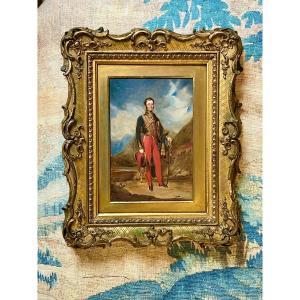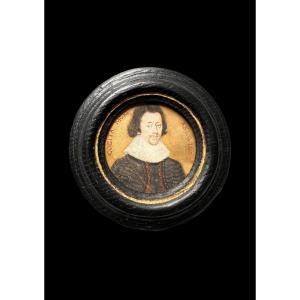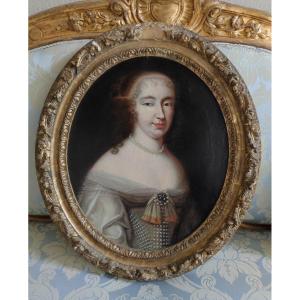The elegant sitter is depicted half length within an oval cartouche and she is dressed in the high status and fashionable brightly coloured silk clothing of the period. Gold or saffron coloured robes such as the one worn by our sitter were extremely fashionable and costly.
Her costume has a low and wide neckline that reveals her décolletage, it also has jewelled fastenings and her shawl is held in place by a gem and pearl set brooch at her bosom. Her luxuriant locks are pinned upwards, and a single curl tumbles across her bare shoulder. Her look is complete by large pearl drop earrings and a single strand pearl necklace.
Throughout the 17th century there was a thriving trade in pearls, which were transported from Asia to Europe. The Golf of Manner (between South India and Sri Lanka) was one of the pearl diving hotspots of the period. Divers would weight themselves with heavy stones to plunge into the depths, and they often had to retrieve as many as 1000 oysters before they discovered a single pearl.
With her jewel studied dress, earrings, and necklace, it his clear that this noble lady had wealth in abundance.
David Scougall (c.1610-c.1680)
Following the restoration of the Monarchy in 1660, Scottish portraiture came to a rise as many members of the nobility gained power and wanted to profess their wealth and status by having their portraits painted. One artist above all others dominated the field and that was David Scougall (c. 1630-1685).
During the 1660s and 1670s David Scougall was particularly prolific, and he received many commissions, largely from members of the Scottish nobility (such as the Napier family) and they were also often prominent members of the new parliament.
His work may have been influenced by fashionable London painters such as Sir Peter Lely (1618-1680)and later on Sir Godfrey Kneller (1646-1723), but it also has an individuality which makes his paintings unique and distinctive.
His son John Scougall (1657-1737) expanded the practice into a portrait studio in the 1680s, and explicitly called himself a limner throughout his life. He painted many portraits in the course of the following decades.
This sensual, arresting and well characterised work is in an excellent state of conservation and is offered ready to hang and enjoy in lots likely original antique frame which is itself a work of art.
I am most grateful to Dr Carla van de Puttelaar, Art Historian for confirming authorship upon viewing this work in person, and her report on this portrait will be provided in full to the purchaser.
Higher resolution images on request.
Worldwide shipping available.
Canvas: 30” x 24" / 76.55cm x 61cm.
Framed: 36" x 30" / 92cm x 76cm.













































 Le Magazine de PROANTIC
Le Magazine de PROANTIC TRÉSORS Magazine
TRÉSORS Magazine Rivista Artiquariato
Rivista Artiquariato